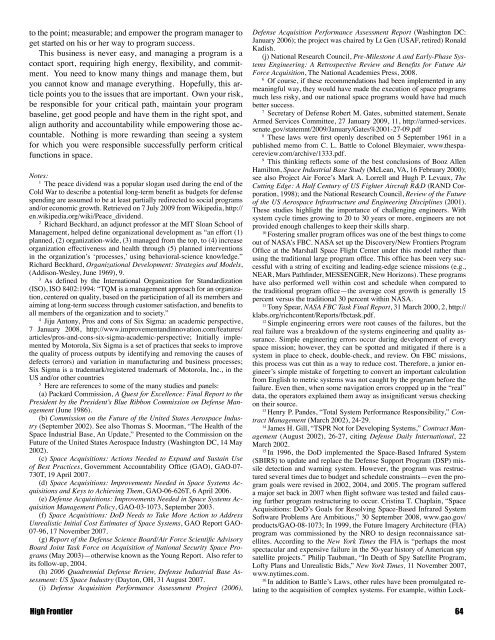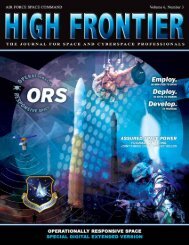Space Acquisition - Air Force Space Command
Space Acquisition - Air Force Space Command
Space Acquisition - Air Force Space Command
Create successful ePaper yourself
Turn your PDF publications into a flip-book with our unique Google optimized e-Paper software.
to the point; measurable; and empower the program manager to<br />
get started on his or her way to program success.<br />
This business is never easy, and managing a program is a<br />
contact sport, requiring high energy, flexibility, and commitment.<br />
You need to know many things and manage them, but<br />
you cannot know and manage everything. Hopefully, this article<br />
points you to the issues that are important. Own your risk,<br />
be responsible for your critical path, maintain your program<br />
baseline, get good people and have them in the right spot, and<br />
align authority and accountability while empowering those accountable.<br />
Nothing is more rewarding than seeing a system<br />
for which you were responsible successfully perform critical<br />
functions in space.<br />
Notes:<br />
1<br />
The peace dividend was a popular slogan used during the end of the<br />
Cold War to describe a potential long-term benefit as budgets for defense<br />
spending are assumed to be at least partially redirected to social programs<br />
and/or economic growth. Retrieved on 7 July 2009 from Wikipedia, http://<br />
en.wikipedia.org/wiki/Peace_dividend.<br />
2<br />
Richard Beckhard, an adjunct professor at the MIT Sloan School of<br />
Management, helped define organizational development as “an effort (1)<br />
planned, (2) organization-wide, (3) managed from the top, to (4) increase<br />
organization effectiveness and health through (5) planned interventions<br />
in the organization’s ‘processes,’ using behavioral-science knowledge.”<br />
Richard Beckhard, Organizational Development: Strategies and Models,<br />
(Addison-Wesley, June 1969), 9.<br />
3<br />
As defined by the International Organization for Standardization<br />
(ISO), ISO 8402:1994: “TQM is a management approach for an organization,<br />
centered on quality, based on the participation of all its members and<br />
aiming at long-term success through customer satisfaction, and benefits to<br />
all members of the organization and to society.”<br />
4<br />
Jiju Antony, Pros and cons of Six Sigma: an academic perspective,<br />
7 January 2008, http://www.improvementandinnovation.com/features/<br />
articles/pros-and-cons-six-sigma-academic-perspective; Initially implemented<br />
by Motorola, Six Sigma is a set of practices that seeks to improve<br />
the quality of process outputs by identifying and removing the causes of<br />
defects (errors) and variation in manufacturing and business processes;<br />
Six Sigma is a trademark/registered trademark of Motorola, Inc., in the<br />
US and/or other countries<br />
5<br />
Here are references to some of the many studies and panels:<br />
(a) Packard Commission, A Quest for Excellence: Final Report to the<br />
President by the President’s Blue Ribbon Commission on Defense Management<br />
(June 1986).<br />
(b) Commission on the Future of the United States Aerospace Industry<br />
(September 2002). See also Thomas S. Moorman, “The Health of the<br />
<strong>Space</strong> Industrial Base, An Update,” Presented to the Commission on the<br />
Future of the United States Aerospace Industry (Washington DC, 14 May<br />
2002).<br />
(c) <strong>Space</strong> <strong>Acquisition</strong>s: Actions Needed to Expand and Sustain Use<br />
of Best Practices, Government Accountability Office (GAO), GAO-07-<br />
730T, 19 April 2007.<br />
(d) <strong>Space</strong> <strong>Acquisition</strong>s: Improvements Needed in <strong>Space</strong> Systems <strong>Acquisition</strong>s<br />
and Keys to Achieving Them, GAO-06-626T, 6 April 2006.<br />
(e) Defense <strong>Acquisition</strong>s: Improvements Needed in <strong>Space</strong> Systems <strong>Acquisition</strong><br />
Management Policy, GAO-03-1073, September 2003.<br />
(f) <strong>Space</strong> <strong>Acquisition</strong>s: DoD Needs to Take More Action to Address<br />
Unrealistic Initial Cost Estimates of <strong>Space</strong> Systems, GAO Report GAO-<br />
07-96, 17 November 2007.<br />
(g) Report of the Defense Science Board/<strong>Air</strong> <strong>Force</strong> Scientific Advisory<br />
Board Joint Task <strong>Force</strong> on <strong>Acquisition</strong> of National Security <strong>Space</strong> Programs<br />
(May 2003)—otherwise known as the Young Report. Also refer to<br />
its follow-up, 2004.<br />
(h) 2006 Quadrennial Defense Review, Defense Industrial Base Assessment:<br />
US <strong>Space</strong> Industry (Dayton, OH, 31 August 2007.<br />
(i) Defense <strong>Acquisition</strong> Performance Assessment Project (2006),<br />
Defense <strong>Acquisition</strong> Performance Assessment Report (Washington DC:<br />
January 2006); the project was chaired by Lt Gen (USAF, retired) Ronald<br />
Kadish.<br />
(j) National Research Council, Pre-Milestone A and Early-Phase Systems<br />
Engineering: A Retrospective Review and Benefits for Future <strong>Air</strong><br />
<strong>Force</strong> <strong>Acquisition</strong>, The National Academies Press, 2008.<br />
6<br />
Of course, if these recommendations had been implemented in any<br />
meaningful way, they would have made the execution of space programs<br />
much less risky, and our national space programs would have had much<br />
better success.<br />
7<br />
Secretary of Defense Robert M. Gates, submitted statement, Senate<br />
Armed Services Committee, 27 January 2009, 11, http://armed-services.<br />
senate.gov/statemnt/2009/January/Gates%2001-27-09.pdf<br />
8<br />
These laws were first openly described on 5 September 1961 in a<br />
published memo from C. L. Battle to Colonel Bleymaier, www.thespacereview.com/archive/1333.pdf.<br />
9<br />
This thinking reflects some of the best conclusions of Booz Allen<br />
Hamilton, <strong>Space</strong> Industrial Base Study (McLean, VA, 16 February 2000);<br />
see also Project <strong>Air</strong> <strong>Force</strong>’s Mark A. Lorrell and Hugh P. Levaux, The<br />
Cutting Edge: A Half Century of US Fighter <strong>Air</strong>craft R&D (RAND Corporation,<br />
1998); and the National Research Council, Review of the Future<br />
of the US Aerospace Infrastructure and Engineering Disciplines (2001).<br />
These studies highlight the importance of challenging engineers. With<br />
system cycle times growing to 20 to 30 years or more, engineers are not<br />
provided enough challenges to keep their skills sharp.<br />
10<br />
Fostering smaller program offices was one of the best things to come<br />
out of NASA’s FBC. NASA set up the Discovery/New Frontiers Program<br />
Office at the Marshall <strong>Space</strong> Flight Center under this model rather than<br />
using the traditional large program office. This office has been very successful<br />
with a string of exciting and leading-edge science missions (e.g.,<br />
NEAR, Mars Pathfinder, MESSENGER, New Horizons). These programs<br />
have also performed well within cost and schedule when compared to<br />
the traditional program office—the average cost growth is generally 15<br />
percent versus the traditional 30 percent within NASA.<br />
11<br />
Tony Spear, NASA FBC Task Final Report, 31 March 2000, 2, http://<br />
klabs.org/richcontent/Reports/fbctask.pdf.<br />
12<br />
Simple engineering errors were root causes of the failures, but the<br />
real failure was a breakdown of the systems engineering and quality assurance.<br />
Simple engineering errors occur during development of every<br />
space mission; however, they can be spotted and mitigated if there is a<br />
system in place to check, double-check, and review. On FBC missions,<br />
this process was cut thin as a way to reduce cost. Therefore, a junior engineer’s<br />
simple mistake of forgetting to convert an important calculation<br />
from English to metric systems was not caught by the program before the<br />
failure. Even then, when some navigation errors cropped up in the “real”<br />
data, the operators explained them away as insignificant versus checking<br />
on their source.<br />
13<br />
Henry P. Pandes, “Total System Performance Responsibility,” Contract<br />
Management (March 2002), 24-29.<br />
14<br />
James H. Gill, “TSPR Not for Developing Systems,” Contract Management<br />
(August 2002), 26-27, citing Defense Daily International, 22<br />
March 2002.<br />
15<br />
In 1996, the DoD implemented the <strong>Space</strong>-Based Infrared System<br />
(SBIRS) to update and replace the Defense Support Program (DSP) missile<br />
detection and warning system. However, the program was restructured<br />
several times due to budget and schedule constraints—even the program<br />
goals were revised in 2002, 2004, and 2005. The program suffered<br />
a major set back in 2007 when flight software was tested and failed causing<br />
further program restructuring to occur. Cristina T. Chaplain, “<strong>Space</strong><br />
<strong>Acquisition</strong>s: DoD’s Goals for Resolving <strong>Space</strong>-Based Infrared System<br />
Software Problems Are Ambitious,” 30 September 2008, www.gao.gov/<br />
products/GAO-08-1073; In 1999, the Future Imagery Architecture (FIA)<br />
program was commissioned by the NRO to design reconnaissance satellites.<br />
According to the New York Times the FIA is “perhaps the most<br />
spectacular and expensive failure in the 50-year history of American spy<br />
satellite projects.” Philip Taubman, “In Death of Spy Satellite Program,<br />
Lofty Plans and Unrealistic Bids,” New York Times, 11 November 2007,<br />
www.nytimes.com.<br />
16<br />
In addition to Battle’s Laws, other rules have been promulgated relating<br />
to the acquisition of complex systems. For example, within Lock-<br />
High Frontier 64











